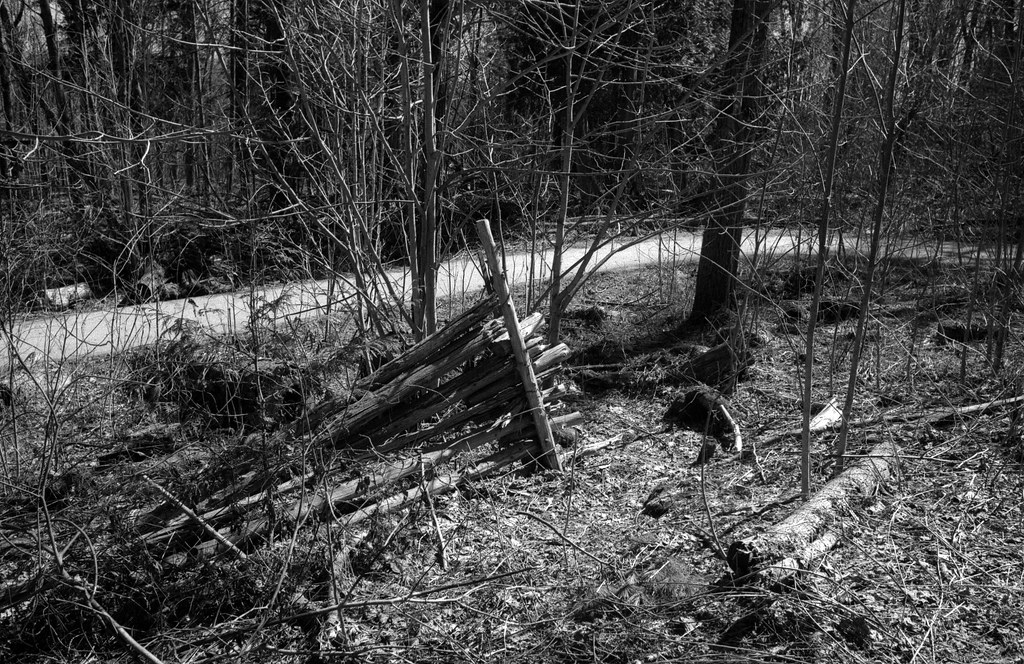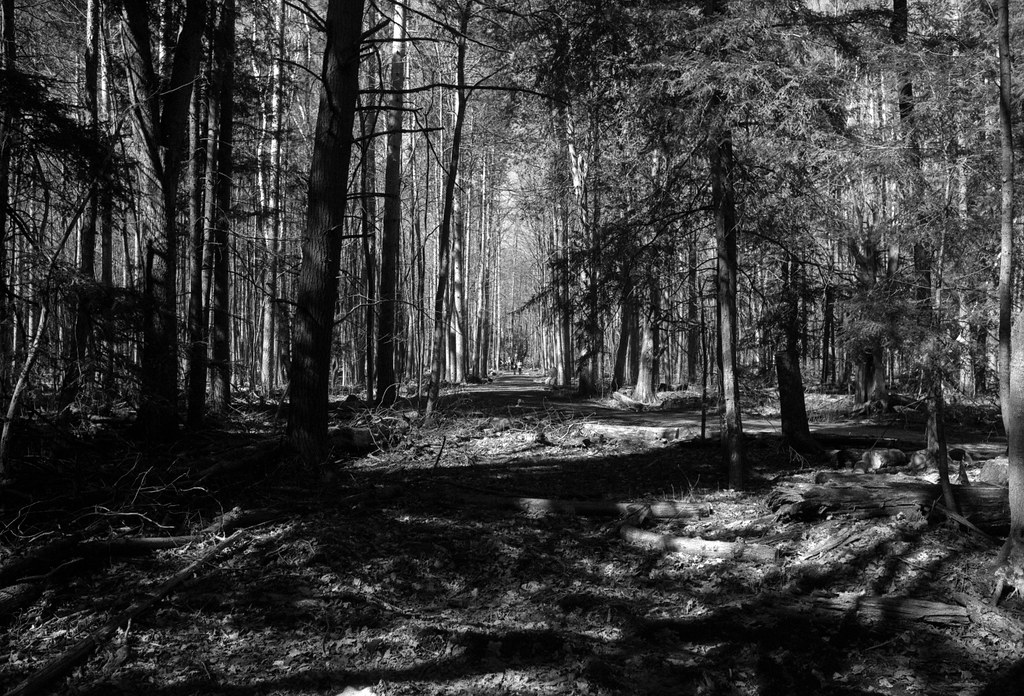One of the area’s biggest geological features in the Niagara Escarpment, covered in ancient Carolinian forests, is instantly recognisable and helps new arrivals navigate the area always looming over Milton. Hidden deep in this forest is a lake that holds many secrets, distant voices from the past that allows us to see into the times before my ancestors arrived on this content. This week I went for another hike in my second favourite Halton park, Crawford Lake.

Nikon FM – AI Nikkor 28mm 1:3.5 (Yellow-12) – Fomapan 200 @ ASA-200 – Kodak D-76 (1+1) 9:00 @ 20C
The Niagara Escarpment was formed at the end of the last ice age, a massive limestone cliff that runs from the Niagara Penisula to the Bruce Penisula. Along the top of the escarpment is a lake, and along that lake in the distant past was one of the earliest known human settlements. The first people to settle near the ancient lake came around the 13th century, not much is known about these people, but they are probably related to either the neutral nation or the early formations of the Huron-Wendat tribe. It wouldn’t be for another three hundred years that a small community of Wendat people would make the shores of the lake a base for a small community, some 250 souls. It is unknown what they named the lake, but they built longhouses, hunted game, and farmed corn, and for some unknown reason, they left by the middle of the 15th Century. And the lake remained. While the area came under the Ojibwa’s control (Mississauga’s of the Credit), they never settled permanently. The first Europeans that settled there would arrive after the Anglo-American War of 1812. George Crawford and his family would be among the first to settle in the region and formed the core of those in a settlement known as Campbellville. George’s son, Murray, constructed a mill in 1889 and used the woods around the lake as a source of lumber to help drive his mill’s business. But the lake drew him in, and in 1899, Murray built a small cottage by the shores of the lake and applied Crawford’s family name to the lake. The cottage and mill remained in the Crawford family until after the Second World War; Murray’s grandson, also named Murray, divested the cottage and lake family in 1963. Halton Conversation acquired the area in 1968, which established a series of hiking trails. Studies of the lake in 1971 revealed the lake was meromictic, which means the layers of water do not mix. Studies of the lowest regions revealed the presence of cultivated corn in the layers of sediment. In 1972, Dr William Finlayson, with a team from the University of Western Ontario and the Museum of Archeology of Ontario, began a decade long dig at the site. During the first dig, archaeologist uncovered the foundations of eleven longhouses, millstones, pottery and other artefacts of a pre-contact indigenous village. Halton Conservation worked with indigenous peoples and archaeologists to reconstruct three longhouses and appropriate tools and materials to teach many (including myself) about the lives of those who lived in the area long before we arrived. A second dig in the 21st Century found more of the same, along with another longhouse. Today, the area is a wonderful area for education, hiking, and indigenous art’s admiring.

Nikon FM – AI Nikkor 28mm 1:3.5 (Yellow-12) – Fomapan 200 @ ASA-200 – Kodak D-76 (1+1) 9:00 @ 20C
Nikon FM – AI Nikkor 28mm 1:3.5 (Yellow-12) – Fomapan 200 @ ASA-200 – Kodak D-76 (1+1) 9:00 @ 20C
I knew right from the start that the top image would be of the longhouses on the site. I mean, it does match the theme this week. While I did want to get in closer, many people were milling about, so I kept my distance. I didn’t want to include too many photos of the trails and the endless woods throughout the site, so I started to look for details in the photos I captured that day. This is where the rail fence shot comes from, plus it has always caught my eye heading down into the main trail system. And, of course, the entrance to the red trail loop, which is one we’ve always want to try, but got to do it this time around. One thing that makes Crawford Lake unique is the sculptures by Indigenous artists that litter the trail. They’re always magnets for parents, but I managed to include the wolf and hawk carvings. And finally, one landscape shot looking out over the Nassagaweya Canyon, and a close of up destruction of a native tree, there were many felled trees due to an infestation of the emerald ash borer. Oddly enough, the two shots that I could have included I never ended up getting, a good shot of the lake, and the Crawford Cottage’s concrete remnants, mainly because those are popular spots, and our path never went near either but I’m cool with my results.

Nikon FM – AI Nikkor 28mm 1:3.5 (Yellow-12) – Fomapan 200 @ ASA-200 – Kodak D-76 (1+1) 9:00 @ 20C
Nikon FM – AI Nikkor 28mm 1:3.5 (Yellow-12) – Fomapan 200 @ ASA-200 – Kodak D-76 (1+1) 9:00 @ 20C
Being a simple hike and given the space I was in and who I was with, I stuck with a single lens, the 28mm f/3.5, which was becoming the slowest lens in my Nikon manual focus kit, a fast favourite of mine through this project. I also knew that I would be doing a lot of landscape photography and wanted something wide. Although, to be honest, I could have gotten away with the 35mm f/2.8. But at the end of the day, I’m happy with the results. Given the bright blue sky that we had this day (the first day of spring), I threw on a Yellow filter to improve some sky separation, although there were no clouds. I shot the film at box speed, ASA-200, and did a simple development in Kodak D-76 at 1+1 dilution to help clear out the bottle of the brown D-76. While not my favourite, during the day I processed this roll, I needed something short.

Nikon FM – AI Nikkor 28mm 1:3.5 (Yellow-12) – Fomapan 200 @ ASA-200 – Kodak D-76 (1+1) 9:00 @ 20C
Nikon FM – AI Nikkor 28mm 1:3.5 (Yellow-12) – Fomapan 200 @ ASA-200 – Kodak D-76 (1+1) 9:00 @ 20C
We’re sticking around Halton Region and visiting a small town that once had a big influence, Georgetown, Ontario!